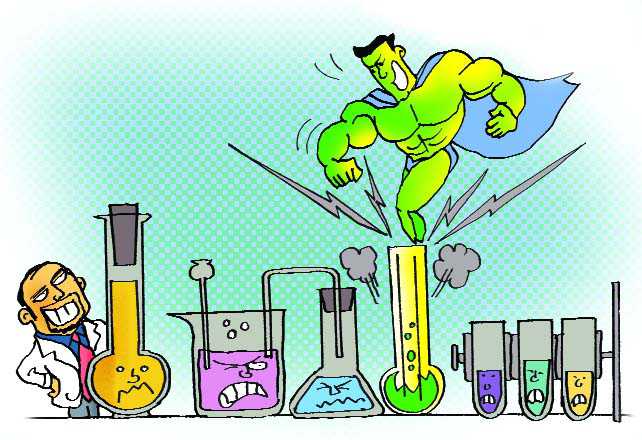I am a tiny chemical. I can only be seen by a powerful microscope. My journey to reach the patient takes 10 to 12 years and could cost up to Rs. 15,000 crores.
Of the thousands who start the journey, only one will be marketed. My dream is to become a superstar – a “blockbuster”, with annual sales of thousands of crores. I would like to be remembered as one who has saved the largest numbers of lives, but that, sadly, is not how life works.
True, the thought of synthetic chemicals (read modern medicines) running amok in human bodies scares many, including those capable of logical, rational thinking. I find it amusing that although we save millions of human lives, few know how a chemical becomes a medicine.
Here is my story. I am often conceived in a public-funded lab, after thousands of man-hours of painstaking research, but will be born a decade later. After birth, some of us die young (rofecoxib), others live long (aspirin) and some are even reborn (thalidomide).
In developed countries, scientists themselves commercialise their ideas or sell them to the industry which conducts subsequent research.
The first step is to test me on animals to find out whether I will be effective in curing the targeted disease. You would assume that once this is done, humans will be the next to be tested. That is not the case. The next step is also on animals but more stringent. Majority of the chemicals are rejected when animals are administered increasing doses of the compound to find out its toxicity and impact on organs.
The past few years have seen animals being replaced by alternative strategies like cell cultures. But we are yet to reach the stage where animal research can be completely abandoned. Interestingly, research animals live in greater comfort than most humans. This is not only because of the increasing emphasis on animal welfare but also because scientists need to keep all research animals in standardised conditions to minimise variability due to extraneous factors.
Based on these results, humans come into the picture with phase 1 clinical trials, often conducted on young healthy volunteers to find out the right dosage and adverse effects. This is never completely foolproof but deaths are rare. This January a healthy volunteer died in France and five fell seriously ill after receiving a new chemical.
There are a lot of ethical debates about enlisting young healthy people instead of patients. But most agree that a youngster has more physiological reserves to deal with adverse effects, if any, compared to an ill person. Volunteers also have to submit quite a lot of blood for analysis and this could be a big risk for the unwell.
The next question is why should a healthy person with a sound mind opt for potentially dangerous research? The main reasons abroad are altruism and money, the latter being quite significant. At home, volunteers give completely different motivations such as “to make contacts” with doctors and get free health checks. The money paid is usually between Rs. 5,000 and 10,000. Once the chemical clears the toxicity bar, the stage is set for phase 2 trials involving small groups (200 – 400) of actual patients. This is more critical to prove the drug is effective on ill patients. The pharma industry bases its go/no-go decisions on results from phase 2 studies.
Phase 3 trials are the most expensive, costing millions of dollars, and often conducted on thousands of patients. A green signal after two such trials, leads to the pharma companies filing applications for marketing. In India, the Drugs Controller General of India takes this decision and the benchmark is the US FDA (Food and Drugs Administration).
Online approvals have now eliminated the earlier carting of truckloads of documents to the FDA resulting in considerable delays. Under the new system, the FDA charges for approvals but many view this as conflict of interest. They quote examples when drugs were approved too quickly and had to be withdrawn later due to serious adverse effects.
My journey continues after marketing as scientists keep looking for adverse effects that went undetected or if I can be useful for other illnesses.
When the patent expires, rival companies bring in similar medicines which are cheaper. This leads to a loss of market share for the inventor who sometimes stops its manufacturing. I am also taken off the market if a better molecule comes along or a rare but serious side effect is detected. This completes my life history.
People commonly boast that they have never taken a medicine all their lives. This may be a sign of good health but not necessarily so. Medicines kill thousands every year but also save millions. Remember, once blood cancer in Hindi films was synonymous with death. Today, many blood cancers are treatable; achievements in AIDS, pneumonia, polio, or anesthetics allow surgeries to be done and organ transplants possible.
As of today there are hardly any magic bullets with no side effects. After all, chemicals are bound to react with millions of body cells. It is unrealistic to expect medicines without adverse effects. In fact, claims that something is natural and thus safe are unsound. Some of the most potent toxins are natural.
I hope you will never need me. But if you do, remember the methodical scientific background and the tenacity of hundreds of researchers who made it possible for me to reach you. I am no substitute for a good lifestyle and can be potentially hazardous. Good physicians understand my limitations, prescribing me only when needed. In the hands of such physicians I am invaluable.
Unlock Exclusive Insights with The Tribune Premium
Take your experience further with Premium access.
Thought-provoking Opinions, Expert Analysis, In-depth Insights and other Member Only Benefits
Already a Member? Sign In Now










